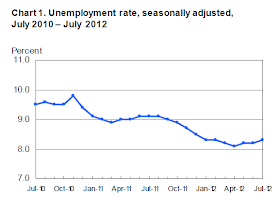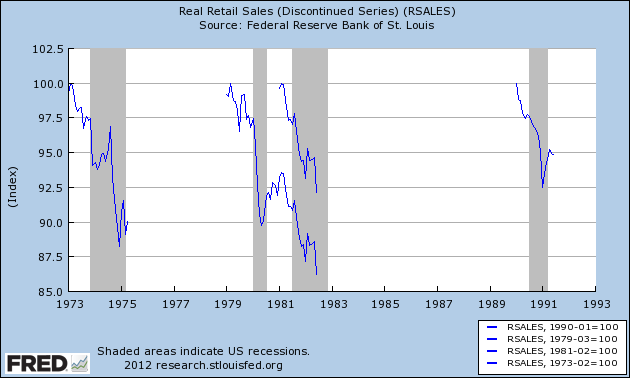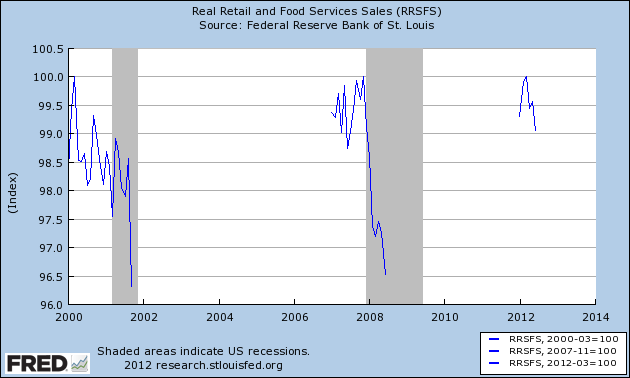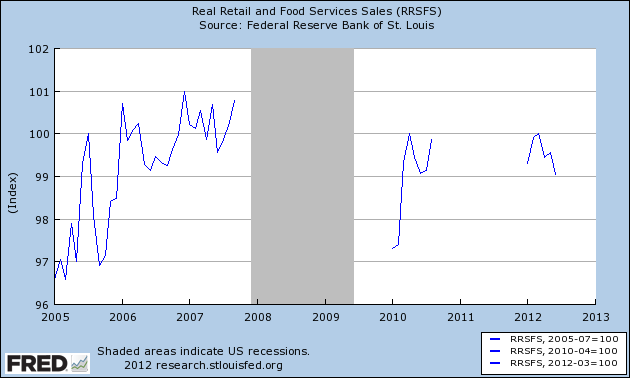- by New Deal democrat
The big monthly numbers this week were obviously the addition of 163,000 jobs in July and the uptick of the employment rate to 8.3%. July car sales held steady. Construction spending increased, especially private residential spending, yet another good sign for the housing rebound. The Case Shiller repeat sales housing price index also improved again month over month, and is very close to turning positive YoY. The ISM services report showed a slight uptick in expansion as did the Chicago PMI. Personal income rose 0.5%, as did second quarter median employment costs. Consumer confidence rose.
On the negative side, ISM manufacturing showed a very slight contraction for the second month in a row. Personal spending was flat. Factory orders declined -0.5%.
On the negative side, ISM manufacturing showed a very slight contraction for the second month in a row. Personal spending was flat. Factory orders declined -0.5%.
Let's start again this week with Same Store Sales, which were quite weak but remained positive:
The ICSC reported that same store sales for the week ending July 28 rose 1.8% w/w, and were up +1.7% YoY. Johnson Redbook reported a 1.1% YoY gain. Shoppertrak, did not report.
The 14 day average of Gallup daily consumer spending showed an upward spike at the end of July and at $77 was $2 over last year's $75 for this period. This is the first week of real strength after six weeks in a row of weakness. This is encouraging but we will have to see if this is just a one week outlier or if consumers are beginning to regain their footing.
Employment related indicators were also mixed to negative this week:
The Department of Labor reported that Initial jobless claims rose 12,000 to 365,000 from the prior week's unrevised figure. The four week average fell another 2250 to 365,500. The lowest 4 week average during the entire recovery has been 363,000. This number does not appear to be compatible at all with further economic weakness.
The Daily Treasury Statement showed that for July 2012, $144.0 B was collected vs. $132.2 B a year ago, an +8.9% improvement. For the last 20 days as of this Thursday, $130.6 B was collected vs. $132.1 B for the same period in 2011, an actual loss of -1.1%. It's possible that this is still being affected by the artifact of the July 4 holiday, but this will disappear next week.
The American Staffing Association Index remained at 92. This index was generally flat during the second quarter 93 +/-1. Having stayed at 92 for 2 weeks when in past years outside of the recession it was rising indicates some weakness.
The energy choke collar remains close to re-engaging:
Gasoline prices rose again last week, up .02 to $3.51. Oil prices per barrel rose slightly for the week, from $90.13 to $91.40. Gasoline usage, at 8820 M gallons vs. 9215 M a year ago, was off -4.3% The 4 week average at 8756 M vs. 9065 M one year ago is off -3.4%, still a significant YoY decline. From here on in declines in energy usage compared with last year have to be considered a sign of renewed weakness unless there is some new surprise level of efficiency compared with one year ago to explain the discrepancy.
Bond prices and credit spreads both decreased again:
Weekly BAA commercial bond rates fell .08% to 4.77%. These are the lowest yields in over 45 years. Yields on 10 year treasury bonds fell 0.5% to 1.47%. The credit spread between the two declined to 3.30%, which while still closer to its 52 week maximum than minimum, is still a significant improvement from one month ago.
Housing reports remained mixed:
The Mortgage Bankers' Association reported that the seasonally adjusted Purchase Index declined -2.1% from the week prior, and were also down approximately -1.5% YoY, back into the middle part of its two year range. The Refinance Index rose 0.8% to yet another 3 year high.
The Federal Reserve Bank's weekly H8 report of real estate loans this week fell -0.1% again. The YoY comparison declined to +0.9%. On a seasonally adjusted basis, these bottomed last September and are up +1.1%.
YoY weekly median asking house prices from 54 metropolitan areas at Housing Tracker were up + 2.2% from a year ago. YoY asking prices have been positive for 8 months.
Money supply remains positive despite now being compared with the inflow tsunami of one year ago:
M1 was flat last week, and was up +3.6% month over month. Its YoY growth rate fell to +16.5%, so Real M1 is up 14.8% YoY. M2 fell -0.1% for the week, and was up 0.9% month/month. Its YoY growth rate fell to 8.4%, so Real M2 grew at +6.7%. Real money supply indicators after slowing earlier this year, have increased again, and YoY comparisons are holding generally steady.
Rail traffic was mixed again, but the diffusion index improved:
The American Association of Railroads reported a +1.0% increase in total traffic YoY, or +5,400 cars. Non-intermodal rail carloads were down -1.5% YoY or -4400, due once again to coal hauling. Negative comparisons fell from 13 to 8 types of carloads. Intermodal traffic was up 9800 or 4.1% YoY.
Turning now to high frequency indicators for the global economy:
The TED spread rose .01 to 0.36, still close to its 52 week low. The one month LIBOR declined to 0.2440. It has retraced about 1/2 of its rise from its recent 4 month range, it remains well below its 2010 peak, and has still within its typical background reading of the last 3 years. Even with the recent scandal surrounding LIBOR, it is probably still useful in terms of whether it is rising or falling.
The Baltic Dry Index fell from 933 to 852. It is still 182 points above its February 52 week low of 670, although well below its October 2011 peak near 2200. The Harpex Shipping Index was steady last week after falling for eight straight weeks at 414. It is still up 39 from its February low of 375.
Finally, the JoC ECRI industrial commodities index fell from 117.10 to 116.70. This is still near its 52 week low. Its recent 10%+ downturn during the last few months remains a strong sign of all that the globe taken as a whole is slipping back into recession.
Weekly indicators were quite mixed. Initial claims, especially as measured over 4 weeks, are sending a good signal. Housing prices are firming. The long leading indicators of housing (especially refinancing), real money supply, and corporate bond yields also continue to be positive. Consumer sales were weakly positive. On the other hand, gasoline prices and sales are a negative. Railroad data was mixed, as were purchase mortgages, and real estate loans were negative. Shipping rates are slipping, and industrial commodities resumed their slide.
I believe we are going to see a very weak July real retail sales number. Going forward the issue as to whether we actually tip into contraction or rebound is probably going to hinge on energy prices and whether real wages turn positive enough to assist in consumer spending.
Have a nice weekend!




















































